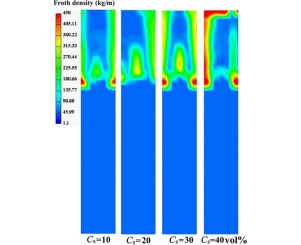Particuology ( IF 3.5 ) Pub Date : 2017-09-01 , DOI: 10.1016/j.partic.2017.04.011 A.R. Sarhan , J. Naser , G. Brooks

|
A new approach for simulating the formation of a froth layer in a slurry bubble column is proposed. Froth is considered a separate phase, comprised of a mixture of gas, liquid, and solid. The simulation was carried out using commercial flow simulation software (FIRE v2014) for particle sizes of 60–150 μm at solid concentrations of 0–40 vol%, and superficial gas velocities of 0.02–0.034 m/s in a slurry bubble column with a hydraulic diameter of 0.2 m and height of 1.2 m. Modelling calculations were conducted using a Eulerian–Eulerian multiphase approach with k–ε turbulence. The population balance equations for bubble breakup, bubble coalescence rate, and the interfacial exchange of mass and momentum were included in the computational fluid dynamics code by writing subroutines in Fortran to track the number density of different bubble sizes. Flow structure, radial gas holdup, and Sauter mean bubble diameter distributions at different column heights were predicted in the pulp zone, while froth volume fraction and density were predicted in the froth zone. The model was validated using available experimental data, and the predicted and experimental results showed reasonable agreement. To demonstrate the effect of increasing solid concentration on the coalescence rate, a solid-effect multiplier in the coalescence efficiency equation was used. The solid-effect multiplier decreased with increasing slurry concentration, causing an increase in bubble coalescence efficiency. A slight decrease in the coalescence efficiency was also observed owing to increasing particle size, which led to a decrease in Sauter mean bubble diameter. The froth volume fraction increased with solid concentration. These results provide an improved understanding of the dynamics of slurry bubble reactors in the presence of hydrophilic particles.
中文翻译:

粒径和浓度对浆液鼓泡塔中气泡聚结和泡沫形成的影响
提出了一种模拟浆液鼓泡塔中泡沫层形成的新方法。泡沫被认为是分离的相,由气体,液体和固体的混合物组成。使用商业流动模拟软件(FIRE v2014)对固含量为0–40 vol%的颗粒大小为60–150μm,表观气体速度为0.02–0.034 m / s的浆液鼓泡塔进行了模拟。液压直径为0.2 m,高度为1.2 m。使用k-ε的欧拉-欧拉多相方法进行建模计算湍流。通过在Fortran中编写子例程以跟踪不同气泡大小的数量密度,气泡破裂,气泡聚结率以及质量和动量的界面交换的总体平衡方程包括在计算流体动力学代码中。在纸浆区中预测了在不同塔高处的流动结构,径向气体滞留率和Sauter平均气泡直径分布,而在泡沫区中预测了泡沫体积分数和密度。利用现有的实验数据对模型进行了验证,预测结果与实验结果吻合良好。为了证明增加固体浓度对聚结速率的影响,在聚结效率方程式中使用了固体效应乘数。随着浆液浓度的增加,固相倍增系数降低,从而导致气泡聚结效率提高。由于粒径增加,聚结效率也略有下降,这导致Sauter平均气泡直径减小。泡沫体积分数随固体浓度而增加。这些结果提供了对在亲水性颗粒存在下的浆料鼓泡反应器的动力学的更好的理解。



























 京公网安备 11010802027423号
京公网安备 11010802027423号